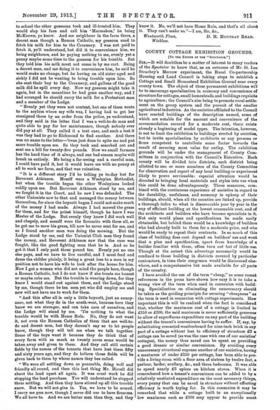COUNTY COTTAGE EXHIBITION GROUNDS.
[To THE EDITOR OF THE " SPECTATOR.")
Sin,—It will doubtless be a matter of interest to many readers of the Spectator to know that, as an outcome of Mr. St. Loe Strachey's Merrow experiment, the Rural Co-partnership Housing and Land Council is taking steps to establish a Cottage and Small Homestead Exhibition Ground near every county town. The object of these permanent exhibitions will be to encourage specialisation in economy and convenience of structure for cottages, small homesteads, and buildings requisite to agriculture; the Council's aim being to promote rural settle- ment on the group system and the pursuit of the smaller agricultural industries. As the societies affiliated to the Council have erected buildings of the description named, some of which are notable for the amount and convenience of the accommodation secured for a moderate cost, there exists already a beginning of model types. The intention, however, is not to limit the exhibition to buildings erected by societies, but to invite specialisation by architects or any persons or firms competent to contribute some factor towards the result of securing most value for outlay. The exhibition grounds will be under the management of County Com- mittees in conjunction with the Council's Executive. Each county will be divided into districts, each district being allotted to one or more members of the County Committee for observation and report of any local building or experiment likely to prove serviceable: especial attention would be directed to bringing local materials and styles into use when this could be done advantageously. These measures, com- bined with the continuous experience of societies in regard to the durability, usefulness, and economy in upkeep of their buildings, should, when all the counties are linked up, provide a thorough index to what is discoverable year by year in the way of efficient building at the lowest reasonable cost, and of the architects and builders who have become specialists in it. Not only would plans and specifications be made easily obtainable, but behind them would be a knowledge of builders who had already built to them for a moderate price, and who would be ready to repeat their contracts. In so much of this class of building does cost depend on builders' use and wont that a plan and specification, apart from knowledge of a builder familiar with them, often turn out but of little use. Though at the outset this advantage necessarily would be confined to those building in districts covered by particular contractors, in time their congeners would be discovered else- where, and a comprehensive list made available for all parts of the country.
I have avoided the use of the term "cheap," as some recent references in the press have shown how easy it is to take a wrong view of the term when used in connexion with build. ing. Specialisation on eliminating the unnecessary should be taken as the guiding principle for securing "cheapness" as the term is used in connexion with cottage experiments. How important this is will be realized when the fact is considered that, whether the maximum cost of a cottage is limited to £150 or £200, the said maximum is never sufficiently generous to allow of superfluous expenditure on any part of the building without the tenant's convenience having to suffer. If, say, by substituting creosoted weatherboard for nine-inch brick in any part of a cottage without loss to efficiency of structure £3 a cottage can be saved (as was the case with one of our societies' cottages), the money thus saved can be spent on providing a good dresser or similar convenience. By avoiding every unnecessary structural expense another of our societies, having a maximum of under £150 per cottage, has been able to pro- vide a living-room with a floor area of sixteen by twelve feet, a parlour, larder, scullery, &c., and three bedrooms. It was able to spend nearly £3 apiece on kitchen stoves. When it is remembered how a tenant's convenience can be added to by a relatively unstinted expenditure on the most necessary things, every penny that can be saved in structure without affecting efficiency is worth trying for. In this connexion it may be remarked that while a cottage built to an exceptionally low maximum such as £100 may appear to provide scant
accommodation, the true test is whether it shows a system of structure which is an advance on previous experiments, and which if applied on a larger scale would give more accom- modation for a given sum than heretofore. In fact, to paraphrase an old saying, any architect or builder who can make a given sum produce two feet of floor area which hitherto has only produced one is a benefactor of his kind. In connexion with our county exhibition grounds, though it will not be practicable to fix any general maximum, in all cases the principle of building encouraged will be of the kind indicated in the foregoing paragraph.—I am, Sir, &c., Secretary R. C. H. & L. C.
[All friends of the rural labourer will welcome this admirable proposal. When a man is shivering on the brink of cottage-building a gentle shove is often necessary. None is better than to be able to tell him to go to some place near and see a cottage which has been actually built for £110 or £150, and can be repeated for him. Such realities are worth a wilderness of paper designs and specifications which have never materialized. We wish the Council all possible success in their original and plucky scheme. What they will be doing is to familiarize the country at a dozen centres with cheap and efficient models.—En. Spectator.]



















































 Previous page
Previous page